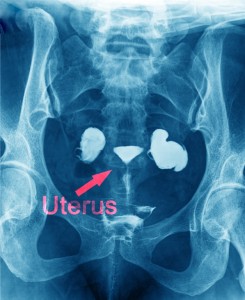In the first place, a woman may present with an abnormal vaginal bleed. To be sure, one of the first diagnostic tests for cancer of the uterus that the gynecologist will likely do is a dilatation and curettage. Notably, this is done in two parts (called “fractional D&C”), first the cervical canal portion, second the uterine cavity portion. For one thing, it allows the specialist to send separate tissue samples to the pathologist for tissue diagnosis.
Specifically, if the cervical sample is free of tumor and the uterine curettage sample shows cancer tissue, the diagnosis of uterine cancer is made. Histologically uterine cancer is usually an “adenocarcinoma”, that is to say that the tumor arose out of glandular tissue from the lining of the uterus.
Work-up for uterine cancer
First, a thorough complete physical examination and a work-up is done. This includes a pelvic examination, chest X-ray and a CT scan of the abdomen and pelvis. Second, liver blood tests and kidney function tests are obtained. Also, tumor markers such as CA 125 and others are tested as they can be elevated in some cases.
Given that uterine cancer tends to invade into the bladder and rectal area, the gynecologist usually performs two endoscopic procedures (a cystoscopy and proctosigmoidoscopy) to ensure freedom of metastases in these areas. Occasionally special other tests such as lymphography or MRI scans of suspicious areas may have to be done to rule out lymph gland or distant metastases.
References
1. Cancer: Principles &Practice of Oncology.4th edition. Edited by Vincent T. DeVita, Jr. et al. Lippincott, Philadelphia,PA, 1993. Vol. 1. Chapter on gynecological tumors.
2. Cancer: Principles&Practice of Oncology. 5th edition, volume 1. Edited by Vincent T. DeVita, Jr. et al. Lippincott-Raven Publ., Philadelphia,PA, 1997. Chapter on gynecological tumors.
3. B. Sears: “The age-free zone”. Regan Books, Harper Collins, 2000.
4. E Weiderpass et al. Cancer Causes Control 2000 Feb;11(2):185-192.
5. S Shibutani et al. Cancer Res 2001 May 15;61(10):3925-3931.
6. DB Fournier et al. Gynecol Oncol 2001 Jun;81(3):366-372.
7. DS McMeekin et al. Gynecol Oncol 2001 May;81(2):273-278.
8. LA Katz et al. Am J Obstet Gynecol 2001 May;184(6):1071-1073.
9. B Bonanni et al. Breast J 2000 Oct;6(5):317-323.
10. MG Jain et al. Eur J Epidemiol 2000;16(10):899-905.
11. Conn’s Current Therapy 2004, 56th ed., Copyright © 2004 Elsevier
12. Ferri: Ferri’s Clinical Advisor: Instant Diagnosis and Treatment, 2004 ed., Copyright © 2004 Mosby, Inc







